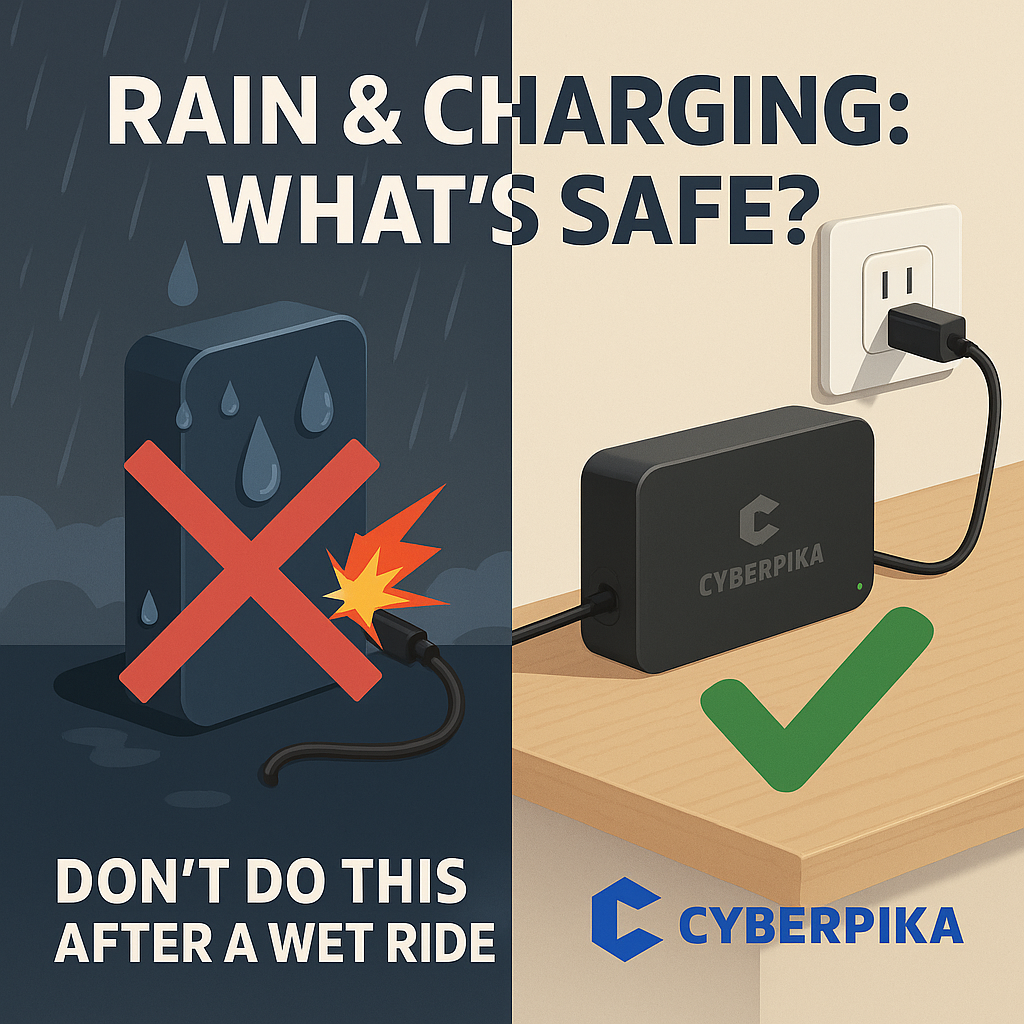You've invested in an e-bike to conquer any weather, but when it comes to charging, a little water can be a big problem. Riding in the rain is one thing, but can you safely charge your e-bike in a wet, rainy, or humid environment?
The answer isn’t as simple as “yes” or “no.” It comes down to understanding a simple safety code and practicing some smart, common-sense habits. This guide will help you decipher IP ratings and navigate the dos and don'ts of charging your e-bike in wet conditions.
Deciphering the Code: What Your IP Rating Means
The Ingress Protection (IP) rating is a standardized code that tells you how well your e-bike's components—especially the battery and motor—are sealed against intrusion from solid objects (like dust) and liquids (like water). It's a two-digit number.
- First Digit (Solids): This number tells you how well a device is protected from solid objects, from large tools to fine dust. A rating of 5 means the device is dust-protected, while a 6 means it is completely dust-tight.
- Second Digit (Liquids): This number is what matters most for water. A rating of 4 means protection against splashes from any direction. A 5 means protection against water jets. A 7 means the device can withstand temporary submersion (up to 1 meter for 30 minutes).
Common E-Bike IP Ratings
Most quality e-bikes have a rating of at least IPX4 or IP54.
- IPX4 or IP54: This is a good baseline for most urban and recreational bikes. It means your bike can handle riding in light to moderate rain and splashing from puddles without damage.
- IPX7 or IP67: This is the highest level of protection you'll commonly find on e-bikes. It means the battery is dust-tight and can withstand heavy downpours and even accidental submersion.
Important Note: Even with a high IP rating, no e-bike is truly "waterproof." They are "water-resistant" to a certain degree.
The Absolute Rules of Charging in Wet Conditions
An e-bike’s IP rating is for riding, not for charging. The charging ports and connectors are often more exposed and vulnerable than the rest of the battery casing. This is where the real risk lies.
Rule #1: Never Charge a Wet E-Bike
This is the single most important rule. Do not, under any circumstances, attempt to charge your e-bike or its battery when it is wet.
- The Risk: Water is an excellent conductor of electricity. Plugging in your charger while water is present in or around the charging port can cause a short circuit, leading to an electrical fire. Even with a high IP rating, a charging port is not designed to be water-tight when the charging cable is inserted.
- The Safe Habit: After a ride in the rain, or if your bike has gotten wet from a wash, take the battery off the bike if possible. Use a dry cloth to wipe down the battery, the charging port, and all connectors. Let the bike and battery air-dry completely in a dry, well-ventilated area for at least a few hours before plugging anything in.
Rule #2: Be Cautious of Humidity
While not as immediately dangerous as direct rain, humidity and condensation can cause long-term damage to your battery.
- The Risk: High humidity can lead to moisture building up inside your battery compartment and on the metal pins of your connectors. This can cause slow, ongoing corrosion, which degrades the performance of your electrical connections over time and can eventually lead to a short circuit.
- The Safe Habit: Store your e-bike, especially the battery, in a dry, temperate environment. A garage or shed is fine, but if you live in a very humid climate, consider bringing the battery inside where the air is more controlled. If you must store your e-bike outside, invest in a waterproof cover to protect it from the elements.
Rule #3: The Charging Location Matters
The golden rule of e-bike charging is to always do it in a safe, dry location.
- The Risk: Charging outdoors in the rain is a major fire hazard. Even on a covered porch, rain can blow in, and the charging components are not designed for this.
- The Safe Habit: Always charge your e-bike indoors, in a dry, well-ventilated space.
Conclusion: Fact, Not Fiction
An e-bike's IP rating gives you the freedom to ride in less-than-ideal weather, but it does not give you permission to charge in it. The charging process is an electrical activity, and electricity and water do not mix. By understanding your e-bike's IP rating and following the simple rules of letting your bike dry out before charging, you are taking the most important step to protect your investment and ensure a safe ride for years to come.


Share:
After the Ride: Cool-Down Rules Before You Plug In
E-Bike Battery Storage & Transport: 40–60% Rule, Fire Safety & Travel Tips